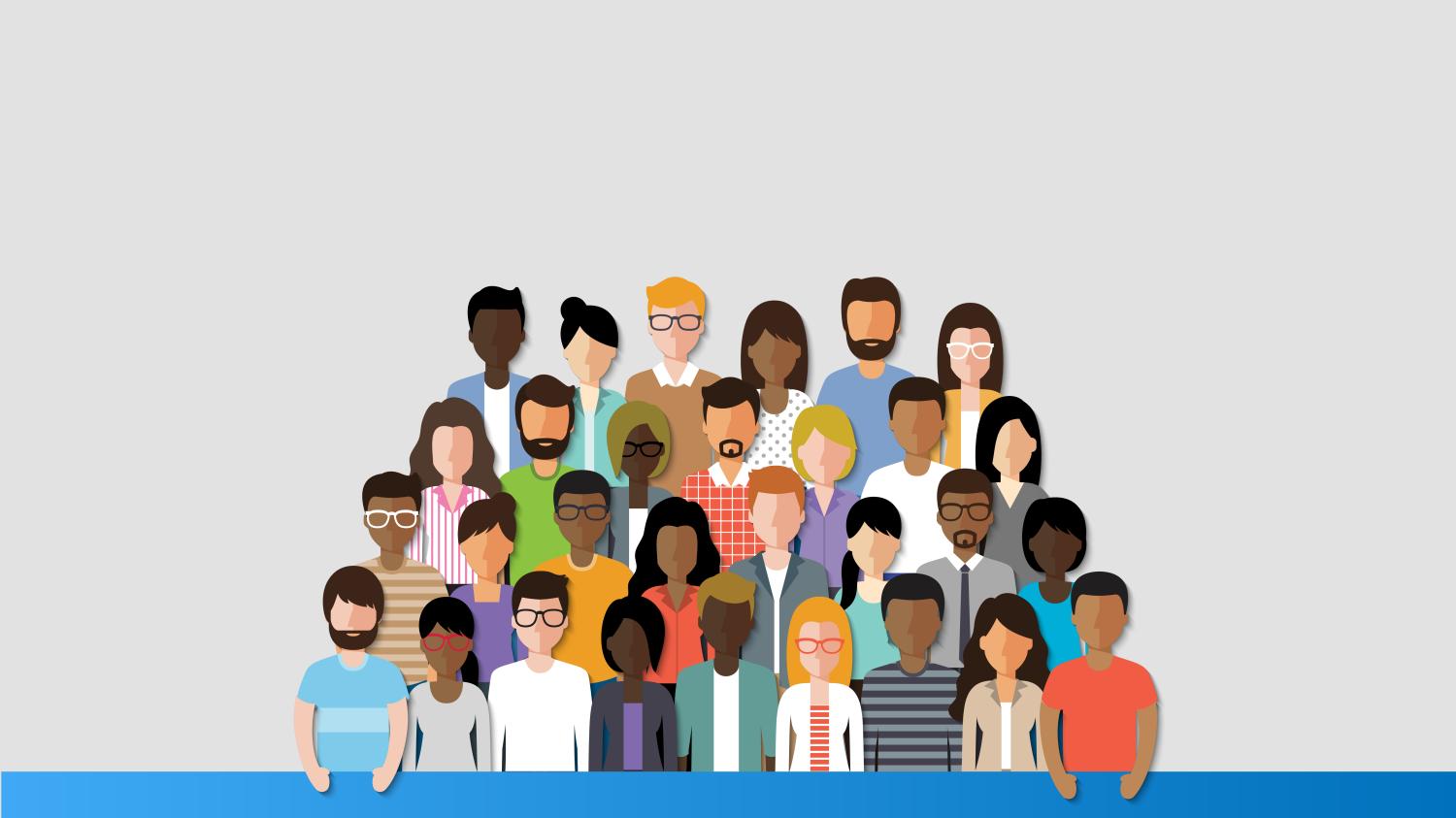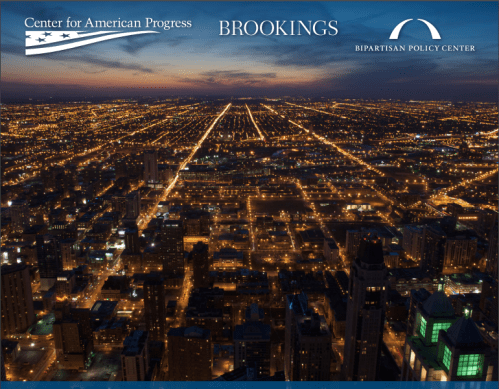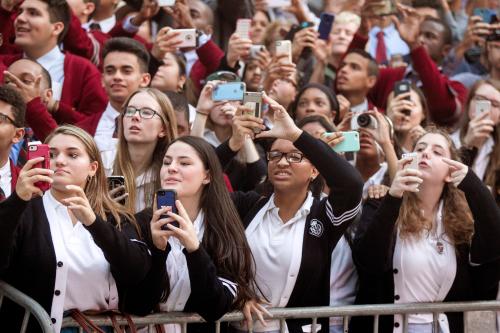The millennial generation, over 75 million strong is America’s largest—eclipsing the current size of the postwar baby boom generation. Millennials make up nearly a quarter of the total U.S. population, 30 percent of the voting age population, and almost two-fifths of the working age population.
Most notably, the millennial generation, now 44 percent minority, is the most diverse adult generation in American history. While its lasting legacy is yet to be determined, this generation is set to serve as a social, economic, and political bridge to chronologically successive (and increasingly) racially diverse generations.
With an emphasis on its unique racial diversity, this report examines the demographic makeup of millennials for the nation, the 100 largest metropolitan areas, and all 50 states.
A bridge spanning the cultural generation gap
Despite today’s divisive generational politics, millennials are poised to become a demographic bridge between the largely white older generations (pre-millennials) and much more racially diverse younger generations (post-millennials). As they progress into middle age, millennials will continue to pave the way for the generations behind them as workers, consumers, and leaders in business and government in their acceptance by and participation in tomorrow’s more racially diverse America.
As the cultural generation gap graphic shows, while both the post-millennial and pre-millennial populations were majority white in 2015 (51.5 percent and 68.4 percent, respectively), both population groups are projected to substantially decrease their shares of white population by 2035, to 46 percent and 64.8 percent, respectively. Yet, even in 2035, the millennial generation will represent a bridge to the more racially diverse young adult population. Read more about the cultural generation gap on page 31
Cultural generation gap: Race/ethnicity projection by ages, 2015 and 2035
What makes millennials unique?
… and how do their characteristics vary by race/ethnicity?
Racial/ethnic diversity
Millennials are by far the most diverse generation when compared to older generations. Most white baby boomers and their elders were born in an era when immigration was at a historic low point and when the immigrants who did arrive in America were mostly white Europeans. Then, the nation’s much smaller minority population was composed mostly of black Americans, residing in highly segregated cities. The large waves of immigration to the U.S. in the 1980s and 1990s, especially from Latin America and Asia, coupled with the aging of the white population1, made millennials a more racially and ethnically diverse generation than any that preceded it. Read more about millennials’ unique racial/ethnic diversity on page 6
Millennials and seniors by race ethnicity, 2015
Education attainment
Compared to older generations at the same relative time in young adult life, millennials have attained higher levels of education, which, for their generation more than others, is tied to higher future earnings and well-being. More than a third of all millennials ages 25-34 achieved college educations by 2015, up from less than 30 percent for comparably aged young adults in 2000 and not quite a quarter for those in 1980.
Notably, postsecondary education attainment has risen for all racial and ethnic young adult groups. There have also been positive changes in related measures such as declines in high school dropout rates and increased college enrollment for all major ethnic groups. Still, there remain sharp disparities in education attainment across groups, with Hispanic and black millennials falling behind their Asian and white counterparts. Read more about millennials’ education attainment statistics on page 12
Education attainment of millennials, ages 25-34, by race/ethnicity, 2015
Homeownership
The housing bust and the Great Recession have affected millennials’ short-term, and potentially long-term, ability to buy homes. Nationally, homeownership rates have not shown long-term declines. They stayed relatively stable since the 1960s except for a housing boom from the late 1990s through 2006. The subsequent housing bust occurred just before most millennials entered the market. This tamped down their homeownership rate compared with young adults at earlier ages, as high interest rates, a reluctance to buy, and debt or low savings prompted many millennials to live with relatives or move to rental housing.
All racial groups registered recent housing-bust-related declines in homeownership, but this was especially the case for blacks who, along with many Hispanics, bore the brunt of fewer lower-cost, subprime loans amid a deficit of resources. This delay in homeownership may be robbing millennials of a head start toward a traditional means of wealth accumulation. Read more about millennials’ homeownership statistics on page 13
Homeownership rates of millennials, ages 25-34, by race/ethnicity, 2015
Poverty
While the economy and employment have climbed back from the worst of the recession and post-recession years, as late as 2015, millennials were more likely to be in poverty than most baby boomers and Gen Xers at similar ages.
A 2016 GenForward Survey of millennials of different racial-ethnic groups found that blacks and Hispanics, in particular, consistently report more economic vulnerability than whites or Asians.2 Moreover, it has been estimated that the loss of wealth resulting from the foreclosure crisis between 2007 and 2009 disproportionately affected black and Hispanic families, making them less able to provide support for their own and their children’s education and home purchases.3 Read more about millennials’ poverty statistics on page 14
Poverty rates of millennials, ages 25-34, by race/ethnicity, 2015
Marital status
Millennials are slower than earlier generations to get married, have children, and leave their parents’ homes. The median age of marriage was lowest during the 1950s—at age 20 for women and 22 for men. By 2015, these rose to ages 27 and 29, respectively. Allowing longer periods for higher education and rising women’s labor force participation have pushed up the ages of marriage and childbearing over the decades. However, the Great Recession and resulting housing crash led millennials to even further delay these domestic milestones.
The broad pattern toward delay in marriage has been followed by millennials in each racial and ethnic group. Blacks continue to exhibit the lowest share of persons who are currently married—halving their share, at ages 25-34, from 47 percent in 1980 to 23 percent. Just as with the national patterns, long term shifts toward later marriage have been amplified for all groups by recent economic conditions. Read more about millennials’ marriage statistics on page 11
Marital status of millennials, ages 25-34, by race/ethnicity, 2015
Where do millennials live?
100 largest metro areas, 2015
An inclusive, diverse America
Millennials are already making an indelible imprint on the nation as evident from the tremendous publicity they receive and the consumer base they represent. Yet, the most consequential characteristic embodied by the members of this unique generation, as the country evolves demographically, is their racial and ethnic diversity.
[related-books]
Despite coming of age in the midst of the Great Recession and the subsequent housing market crash, the racially and ethnically diverse millennial generation tends to be optimistic about the future. Amidst signs that the employment situation is improving, and indications that housing affordability is reviving, a majority of millennials say that they want to get married, have children, and purchase a home.1 Specifically, Hispanic, Asian, and black millennials are more likely than whites to say that they will do better financially than their parents and that the life of their generation will be better than that of their parents.2
By example and as advocates, millennials of all racial and ethnic backgrounds can make the case that investing in a more inclusive America is essential to the nation’s economic success and will, as well, benefit older populations. As they move into middle age, millennials will represent the new face of America in business, in politics, in popular culture, and as the nation’s image to the rest of the world.
Data visualization produced by Alec Friedhoff.
This report draws from a variety of U.S. Census Bureau data, including the Current Population Survey, the American Community Survey, census estimates and projections, as well as historical decennial censuses. It also presents metropolitan area projections conducted by the author. Millennials are defined in this report as persons born between 1981 and 1997.
-
Footnotes
- Joel Kotkin and Wendell Cox, “Fading Promise: Millennial Prospects in the Golden State,” research brief, Center for Demographics & Policy, Chapman University Press: 10-12, http://joelkotkin.com/wp-content/uploads/2017/05/FadingPromise_Millenial-Prospects-in-CA.pdf
- Cathy J. Cohen, Matthew D. Luttig, and Jon C. Rogowski, The Economic Lives of Millennials: GenForward June 2017 Report, http://genforwardsurvey.com/assets/uploads/2017/06/Millennials-Economic-Lives.pdf.






